Dissertation Research Abstract
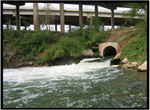
- Dallas Central Wastewater Treatment Plant
Benthic macroinvertebrate community composition studies have been conducted over the past 20 years on the upper Texas Trinity River, which is dominated by wastewater treatment plant (WWTP) and industrial effluents. The Trinity River is created by four forks that converge in the Dallas/Fort Worth Metroplex (DFW) and is the most highly populated and industrialized watershed in Texas. The arid environment, effluent domination, and rapid urbanization of the river creates a “near worst-case” condition for water quality and thus presents an opportunity to
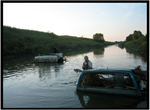
- East Fork of the Trinity River
examine the environmental effects of household and industrial effluents. A study conducted in 1987 - 1988 concluded that many reaches supported diverse benthic communities; however, benthic communities immediately downstream of WWTPs had the lowest biotic indices. Since 1988, DFW has experienced increases in population (>30%) and urban land use, along with improvements in wastewater treatment. This study, initiated in 2005, paralleled the 1987-88 study in order to evaluate how
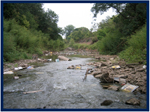
- West Fork of the Trinity River
changes in water quality and habitat caused by factors associated with increased urbanization impact the benthic community structure. Surface water, sediment interstitial water, and sediment were collected from 10 river locations, and effluent was collected from each of the four major WWTPs in DFW. Samples were analyzed for the surfactants alcohol ethoxylates (AE), alkyl ethoxysulfates (AES), and linear alkyl benzene sulfonates (LAS), as well as general in-stream chemistries, habitat quality, and geospatial
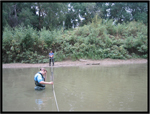
- Habitat Assessment of the West Fork of the Trinity River
factors that may influence surfactant sources and fate. Individual surfactant toxic units (TUs) were found to be very low in the Trinity River flowing through DFW, and thus were combined to produce total TUs for surface water and pore water. Total TUs ranged from 0.06 - 0.14 for surface water and 0.11 - 0.31 for pore water. TU distribution along the Trinity River
was not dependant on WWTP location, and did not correlate with any benthic variable. Fifty-two land use, habitat, and in-stream water chemistry parameters were used in multiple regression
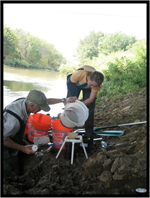
- Benthic Macroinvertebrate Processing on the West Fork of the Trinity River
analyses to predict surfactant TUs and benthic macroinvertebrate ecology. Eight of the 52 environmental parameters were determined to be useful for predicting changes in benthic macroinvertebrate communities, with surface water surfactant TUs, in-stream habitat cover, and surface water total organic carbon being the top 3 parameters.




